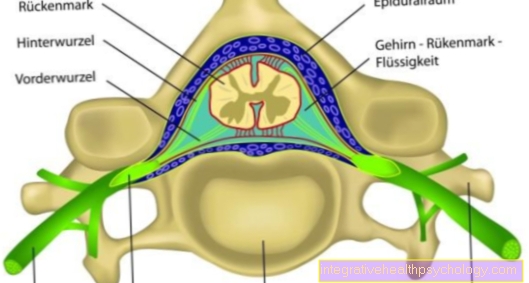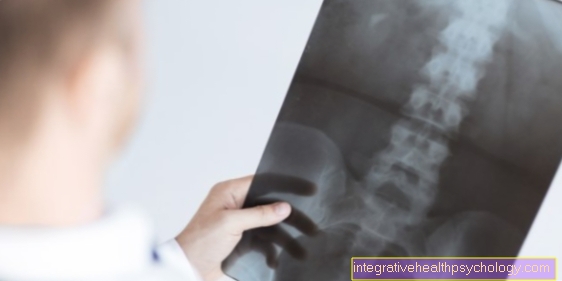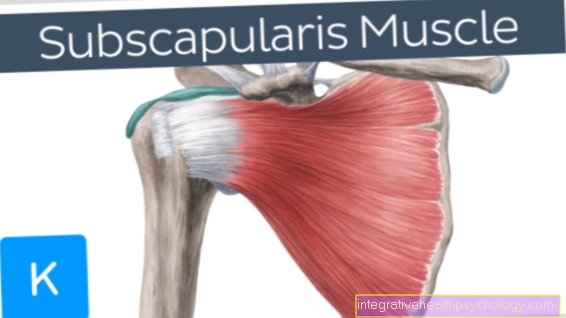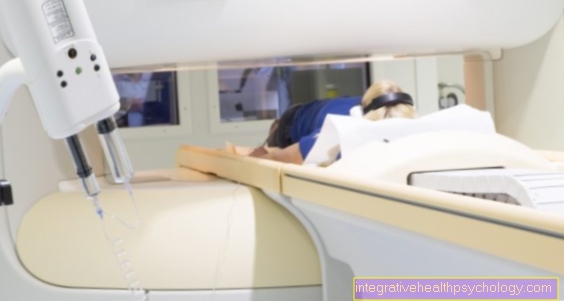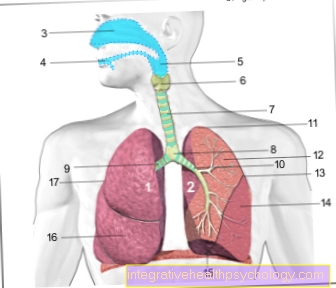Tarsal tunnel syndrome
definition
The tarsal tunnel syndrome is one of the nerve congestion / nerve compression syndromes. A distinction is made between anterior and posterior tarsal tunnel syndrome. The anterior fibular nerve is affected. The posterior is a syndrome in which the tibial nerve is compressed in the so-called tarsal tunnel.
Both go from the sciatic nerve ("Sciatic nerve“).
Posterior tarsal tunnel syndrome is more common. The tibial nerve runs along the back of the lower leg to the lateral foot down to the sole of the foot. It supplies motor muscles of the calf and foot and is therefore responsible, among other things, for tiptoe walking. It takes care of part of the calf and the sole of the foot.
Its course can be narrowed behind the medial ankle. This is where the so-called tarsal tunnel is located, which is bounded by bones from the inside and spanned from the outside by a ligament, the retinaculum flexorum or ligamentum laciniatum.

Anterior tarsal tunnel syndrome
The anterior tarsal tunnel syndrome is a nerve congestion syndrome that affects the N. fibularis profundus (sometimes referred to as the deep peroneal nerve). A synonym is therefore also "Fibularis Syndrome".
The N. fibularis profundus is a nerve branch of the N. fibularis commonis, which in turn is a nerve part (fibularis part) of the Sciatic nerve is. This divides above the Popliteal fossa divided into 2 nerves: N. fibularis communis and N. tibialis. In addition to the N. fibularis profundus, a N. fibularis superficialis also emerges from the fibularis part, namely the two nerve branches separate in the region of the fibular head, more precisely in the M. fibularis longus. For the symptoms, however, the nerve branch N. fibularis profundus is mainly important.
The cause of the anterior tarsal tunnel syndrome is considered to be one Nerve compression in the area of Anklebecause the nerve runs beneath a ligament structure, the retinaculum extensorum inferius (also called ligamentum cruciforme in literature). In addition to the retinaculum, there can also be a muscular structure, the M. extensor hallucis brevis lead to the nerve compression. The narrowing can be provoked by frequent wearing of high heels. Ski boots and mountaineering shoes can also worsen the symptoms. A common cause, as with many other nerve congestion syndromes, is the presence of one Tendinitis, as the affected region swells at the expense of the deep fibular nerve.But even after injuries, the presence of a ganglion (= excess leg, tumor-like tissue changes on the joint capsules or tendon sheaths) or diabetes mellitus can enormously increase the risk of an anterior tarsal tunnel syndrome. Ultimately, however, the state of the pregnancy or a chronic one Circulatory disorder compress the deep fibular nerve.
Anterior tarsal tunnel syndrome can be prevented using Lymphatic drainage, local infiltration from steroids and Local anesthetic, Ointments and insoles be treated conservatively.
If there is no response to conservative treatment, surgery is usually performed.
Posterior tarsal tunnel syndrome
The posterior tarsal tunnel syndrome, however, affects the Tibial nerve and manifests itself in the Inner ankle region. The tibial nerve, the tibial part of the sciatic nerve, runs deep into the Calf muscles, the deep Flexor box, down to the foot. There it pulls on the inside of the ankle through the medial or posterior tarsal tunnel (= canalis malleolaris) onto the sole of the foot. During the passage through the tarsal tunnel, the tibial nerve is divided into two nerve branches, the lateral plantar nerve and the medial plantar nerve.
The passage through the tarsal tunnel is a relevant bottleneck so that a nerve congestion syndrome of the tibial nerve is very likely here. The posterior tarsal tunnel syndrome is also generally more common than the anterior tarsal tunnel syndrome.
The anatomical constriction is due to the compact location of various structures. The retinaculum musculi flexorum, a ribbon-like structure between the medial calcaneus and the medial malleolus, should be emphasized. As with the anterior tarsal tunnel syndrome, injuries, fractures, a ganglion, metabolic diseases (diabetes mellitus, gout, hypothyroidism, etc.) or tendinitis can trigger a space-occupying process that leads to nerve compression. A risk factor for the posterior tarsal tunnel syndrome is the mechanical overload caused by long jogging (“joggers foot”).
Appointment with ?

I would be happy to advise you!
Who am I?
My name is dr. Nicolas Gumpert. I am a specialist in orthopedics and the founder of .
Various television programs and print media report regularly about my work. On HR television you can see me every 6 weeks live on "Hallo Hessen".
But now enough is indicated ;-)
In order to be able to treat successfully in orthopedics, a thorough examination, diagnosis and a medical history are required.
In our very economic world in particular, there is too little time to thoroughly grasp the complex diseases of orthopedics and thus initiate targeted treatment.
I don't want to join the ranks of "quick knife pullers".
The aim of any treatment is treatment without surgery.
Which therapy achieves the best results in the long term can only be determined after looking at all of the information (Examination, X-ray, ultrasound, MRI, etc.) be assessed.
You will find me:
- Lumedis - orthopedic surgeons
Kaiserstrasse 14
60311 Frankfurt am Main
You can make an appointment here.
Unfortunately, it is currently only possible to make an appointment with private health insurers. I hope for your understanding!
For more information about myself, see Lumedis - Orthopedists.
diagnosis
Decisive for the diagnosis are primarily the information provided by the patient during the anamnese (Questioning by the doctor) and the clinical examination. With this there is often pressure pain behind the affected inner ankle, and it is often also Hoffmann-Tinel sign positive. To check this sign, the examiner taps the course of the nerve and can thereby trigger electrifying pain in the patient's complaint area.
Using electrophysiological methods, the Nerve conduction velocity of Tibial nerve being measured by a Tarsal tunnel syndrome is reduced in this area. A test of sweat secretion on the sole of the foot using the Ninhydrin tests can be instructive as this Tarsal tunnel syndrome is often reduced.
What can you see of the ankle in the MRI?
MRI (magnetic resonance tomography) is particularly characterized by the decisive advantage that it can display soft tissue, such as ligaments and cartilage, well. This is particularly useful for diagnosing the ankle, where ligament tears or overstretching and inflammation are particularly common.
Magnetic resonance tomography is based on the movement of atoms and since our body consists to a large extent of water molecules, the movement of these is primarily used for imaging. This can also explain why the lungs or bones are not particularly easy to see on the MRI. There aren't that many water molecules in these tissues.
Symptoms
The symptoms of the front Tarsal tunnel syndrome manifests itself as a painful sensation on the Back of the foot and above the ankle. This pain can occur both at rest and at night, as well as under strain with radiation to the calf. Another characteristic is the Tenderness. In addition to the pain, paresthesia occur in the area between the first two toes, as the deep fibular nerve is responsible for the sensitive supply there (Latin: interdigital space I + II). To a certain extent it can even weaken the Toe extensor muscles come from a compression of the motor nerve parts. This creates problems for those affected when walking.
The symptoms of a rear Tarsal tunnel syndrome are very variable. In principle, the motor or the sensitive parts can fail. Those affected often complain about Numbness in the area of the sole of the foot, since this region is covered by the Nn. plantares is supplied. This is another paresthesia tingle in the toes. With posterior tarsal tunnel syndrome, pain occurs mainly on the underside of the foot and the medial ankle. The character of the pain can range from burning and drawing to stabbing. The pain can be felt both at rest and under stress. Partly is about a sleep-robbing night pain reported. An isolated pain in the heel may indicate that a special nerve branch supplying the heel region (R. calcaneus) is affected. Long-term nerve compression can even cause it to Signs of paralysis (= Paresis) of the foot muscles. Most of the time, the symptoms worsen when you stand or walk for a long time.
At a Tarsal tunnel syndrome both feet don't often go numb.
Tarsal tunnel syndrome is a very common occurrence after long units on the cross trainer. Especially in combination with Buckled feet both feet go numb.
In this case, in almost all cases, there is one Deposit supply after a Treadmill analysis sufficient to eliminate all symptoms.
therapy

At the beginning there is usually an attempt conservative (non-operative) therapy aimed at. The following are used here:
- Painkiller,
- Immobilization of the foot and
- Shoe insoles.
However, contrary to conventional assumptions, the latter have proven to be of little or no help at all.
If the complaints persist despite such treatment, there is the possibility of one surgerywhere the decompression of Tibial nerve The aim is. For this purpose, the Tarsal tunnel spanning Flexor retinaculum split, which makes more space available for the nerves.
Taping
The aim of taping is to support muscular structures and joints in their function and to ensure better stability. Due to their elastic nature, there is no restriction of movement.
Taping is used more and more frequently for the conservative treatment of tarsal tunnel syndrome.
Taping an ankle joint can relieve this and the body, for example, better conditions for healing a tendon sheath inflammation in the sense of faster swelling and the associated decompression of the deep fibular nerve or the tibial nerve. The tape is attached along the course of the affected structures and thus also depends on whether it is an anterior or posterior tarsal tunnel syndrome. The tape should only be attached by trained professionals for optimal effectiveness.
insoles
Wearing insoles can be a first conservative therapeutic approach as well as follow-up care after a surgical procedure, which includes not only relieving footwear, but also physiotherapy and targeted training of mobility.
The use of insoles is particularly useful if the cause of the tarsal tunnel syndrome is a foot malposition such as the "arched arched foot". By wearing specially shaped insoles, the foot position can be optimized to a certain extent, since the insole tries to imitate the normal foot position. Most of the time, the insoles have a supportive arch on the medial, i.e. inner side of the foot, which can support the possibly weak arch of the foot. The aim is to improve the contact surface so that pressure and forces can be distributed more evenly and gently.
surgery
In principle, one tries to alleviate the symptoms first with the conservative variant. If there is no improvement after approx. 8 weeks or if the symptoms recur after improvement, an operation should be considered. In the anterior tarsal tunnel syndrome, conservative therapy helps less often, so that the indication for an operation is often made here. The retinaculum extensorum inferius (ligamentum cruciforme) is severed in order to counteract the compression caused by space-occupying processes.
In the case of the posterior tarsal tunnel syndrome, which is much more common, failure to respond to conservative therapy is a reason for surgery. In order to rule out the suspicion of a ganglion or even a nerve tumor, clarification by MRI or neurosonography is necessary, since in this case a simple severing of the ligament structures to relieve the strain is not a solution in the long term.
The operation generally has two goals: on the one hand, to remove the constriction in the area of the tarsal tunnel and, on the other hand, to ensure that the two nerve branches (Nn. Plantares mediales and lateralis) run through the firm sole plate on the underside of the foot. Nowadays, the procedure can be minimally invasive under general anesthesia. First of all, it is important to orientate yourself correctly in order to choose the best cut. Feeling the pulse of the posterior tibial artery can be helpful here, as it runs through the tarsal tunnel together with the tibial nerve and parts of the tendons. The area to be operated on is then exposed through a skin incision and the retinaculum musculi flexorum pedis, a ribbon-like structure between the medial calcaneus and the medial malleolus, is split. This relieves the pressure and releases the compression. As mentioned, the two Nn. plantares may be relieved. They run separately on the sole of the foot in a muscle fascia of the abductor hallucis muscle. In order to counteract processes that take up space here, the fascia can be split in the appropriate area. The desired decompression can only occur if the nerve is exposed over a longer distance.
A cast should not be placed after the operation, as both the deep fibular nerve and the tibial nerve heal better and faster if they can slide. If the mobility is restricted, the tissue becomes scarred. In addition, the muscle press for venous thrombosis prophylaxis must be able to work again. It is therefore generally recommended to take care of the foot by wearing walking aids for 10 days, but still move it gently and carefully.
The operation has been shown to have good success rates, so that those affected are completely pain-free again. Only slight sensory disturbances can persist for a few days after the operation.
What are the risks of an operation?
The most important thing in a tarsal tunnel operation is the previous and precise diagnosis. There are many causes that can cause pain in the foot area and therefore the impairment of the nerve must be determined via a measurement of the nerve conduction velocity or other neurological evidence before an operation is performed. The main risk with a tarsal tunnel operation is that the operation area is directly stressed by the occurrence. In the first few days, this must be weakened by using crutches or the like.
There is also the risk of scarring of the surgical area, which would lead to a renewed narrowing of the nerve due to the operation. In addition, both the nerve and the artery and vein run through the tarsal tunnel. Errors during the operation can lead to injuries to these vessels and thus to bleeding.
Duration of healing after the operation
The most important thing is to protect the sole of the foot and the forefoot for the first few days after the operation. Of course, you shouldn't completely refrain from moving and running for more than a few days, because otherwise the risk of leg vein thrombosis is too high. So most patients will be given certain blood thinners for a few days to reduce this risk.
In addition, there is always the risk that the muscles will shrink significantly if certain groups are not used for a long time. The exact duration of the healing cannot be specifically predicted, however, as it depends strongly on the regenerative capacity of the nerve in the individual. It can take up to six months and may require a second operation, but depending on the conditions, it can also take a significantly shorter time.
How long will you be unable to work after the operation?
The inability to work after an operation on the tarsal tunnel also depends entirely on the patient's recovery. Usually there is a four to six week sick leave. But that depends entirely on the circumstances of the operation. Whether the left or right foot is affected can affect the ability to drive.
If unintentional scarring has occurred, another operation may have to be performed, which also extends the sick leave. However, if you adhere to the rest and rest periods prescribed by the doctor, in most cases you will be able to return to work after about six weeks.
Which exercises can help?
There are some exercises that can help strengthen the foot muscles and relieve nerve compression or prevent it from returning. However, the exercises should only be performed if the pain caused by them is not exacerbated too much. It is important to do the exercises regularly over a certain period of time so that they are really effective. Most of these exercises can also be incorporated wonderfully into everyday life and always carried out in between.
One of these exercises is called a "swing". The point here is to stand barefoot on tiptoe and from there to "rock" on your heels. This should be done slowly, in a controlled manner and a few times in a row.
Another exercise involves using your toes to pick up a pen or towel that is lying on the floor. In addition, you can use exercises to ensure that the calf muscles are loosened by stretching. During stress, the focus is not concentrated on the ankle, but is caught by the calf muscles. There are all kinds of strategies for doing this; One of the possibilities is to put a noose around your forefoot with a towel and slowly and in a controlled manner to pull the loop so that the toes point upwards.
Can a bandage help?
Bandages that are worn on the joints can generally increase the stability and thus ensure that complaints are more likely to go down and pain caused by stress is reduced. Even with a tarsal tunnel syndrome, a bandage and the stability it provides can be of great benefit.Fundamental bad postures are also restricted or prevented by bandaging a joint. Because bad posture can also cause nerve compression. You can also compensate for such poor posture with insoles that shift the load to the outside of the foot instead of promoting the load on the nerve.
Cause pregnancy
Pregnancy involves many changes in the body. For one, the hormonal balance changes a woman's tissues to prepare her for childbirth. Ligaments loosen to widen the pelvis. However, this of course also loosens all other ligaments in the body. This can reduce the stability in all possible joints and injuries can occur more easily.
Another change during pregnancy is the increasing water retention in the body. Up to 6-7 liters more water than usual can be in a woman's body. This increased water causes edema to form in the body. This irritates nerves and women often have the feeling that their arms or legs have “fallen asleep”. This nerve irritation can of course also lead to tarsal tunnel syndrome. The ankle and foot in particular suffer naturally due to gravity due to the amount of water in the body
Cause thyroid
The thyroid is an important organ in our body that is responsible for a large part of the hormonal balance. Thyroid hormones regulate our metabolism and much more. An overactive or underactive thyroid can result in numerous symptoms.
In addition to palpitations / bradycardia (slow heartbeat), restlessness / listlessness and weight gain / gain, joints and nerves can also be affected. The nerve sheaths (called endo- and perineurium) can be negatively affected by incorrect levels of thyroid hormone in the blood. This can cause tarsal tunnel syndrome.






.jpg)


